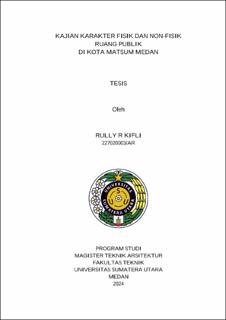| dc.description.abstract | The success of a public space is closely related to its physical and non-physical
characteristics. In the context of urban villages, public space is an important part
of the environmental elements. Therefore, it is important to carry out research that
examines and explores the physical and non-physical characteristics of public
spaces in Kampung Kota (case study: Kota Matsum Medan). The research method
is carried out in a mixed manner, namely qualitative and quantitative.
Qualitatively, researchers collected and analyzed primary data through direct
observation in the field and in-depth interviews with 10 key informants. The data
that is processed quantitatively was obtained through distributing questionnaires
to 100 respondents. All data that has been collected and analyzed qualitatively and
quantitatively is presented descriptively. The results of the study show that the
physical characteristics of public spaces in Kota Matsum, Medan have an influence
on social interactions. In this urban village, alleys not only function as
circulation/accessibility routes but also as community gathering spaces. Even
though the public space in this environment is not physically comfortable, the
community's high social ties and economic considerations encourage the formation
of a comfortable feeling for gathering and socializing. In terms of spatial
dimensions, the narrower the width of the alley, the higher the social power created
in this urban village. Overall, it can be concluded that the research results show
that the physical (type of space, accessibility, and space comfort) and non-physical
(community activity and sociability) characteristics of public spaces in Kota
Matsum, Medan, are similar to public spaces in other urban villages. The results
of the research can be used as consideration for city planners to accommodate
settlements that grow unplanned in the future. | en_US |


